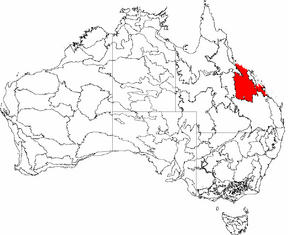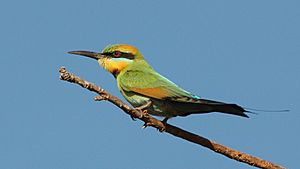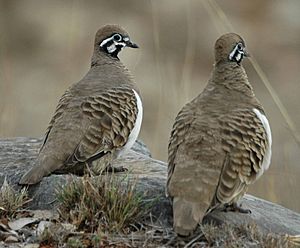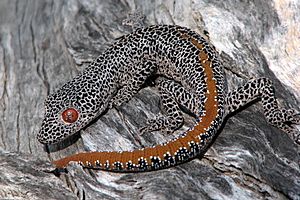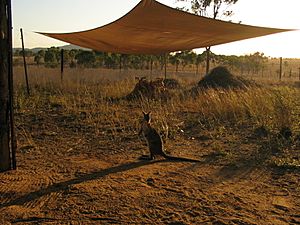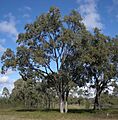Taunton National Park facts for kids
Quick facts for kids Taunton National ParkQueensland |
|
|---|---|
|
IUCN Category II (National Park)
|
|
| Nearest town or city | Emerald |
| Established | 1986 |
| Area | 116 km2 (44.8 sq mi) |
| Managing authorities | Queensland Parks and Wildlife Service |
| See also | Protected areas of Queensland |
Taunton National Park is a special place in Queensland, Australia. It's about 135 kilometers (84 miles) from the city of Rockhampton, near a town called Dingo. The park covers a large area of 11,626 hectares (about 28,730 acres). It is part of a bigger natural area called the Northern Brigalow Belt. This region is known for having many different kinds of plants and animals.
Taunton National Park is a very important nature reserve for science. Its main job is to protect the bridled nail-tail wallaby. This wallaby is an endangered animal. Because the park protects these wallabies, it also helps the land heal itself. It keeps the natural ecosystems safe from farming that happens nearby. The park gives homes to many native animals and helps keep different types of plants and animals safe.
Contents
What the Park is Like
The northern part of the park has sticky clay soils and many brigalow trees. In the western part, you'll find different soils and lots of eucalypt trees. The park's land is mostly flat. It slopes gently from the north and west down to the east and south.
The weather here is warm and dry, like a subtropical desert. On average, it rains about 711 millimeters (28 inches) each year. Half of this rain falls during the summer months, from December to February. Because the rain comes in a short time, the area often has droughts. A big drought happens about once every ten years. A serious drought from 1991 to 1995 hurt the wallaby population a lot.
Taunton National Park has open, grassy eucalypt woodlands. It also has areas where acacia shrubs and forests are growing back. These are the main plant areas in the park. The most common trees are brigalow (Acacia harpophylla) and poplar box (Eucalyptus populnea). You can also find other types of Acacia and Eucalyptus trees. The park has 15 dams and a few small creeks for water.
Park History
The area around Taunton National Park has been used for farming for a long time. In the 1950s and 1960s, many brigalow forests were cut down. This was done to create pastures for sheep and cattle. A grass called buffel grass (Cenchrus ciliaris) was planted widely. It quickly spread and became a permanent part of the land.
A government plan called the 'Brigalow Development Scheme' encouraged more farming. This sped up how quickly forests were cleared for buffel grass. Because this plan worked so well, people started using the land more intensely. Properties became smaller, and more animals were raised. All these changes meant that less natural forest was left. This reduced the homes, food, and shelter for native animals. It also changed the natural mix of plants.
How the Park Started
In 1973, a bridled nail-tail wallaby was seen on a cattle farm named 'Taunton'. A fence builder reported the sighting. People thought these wallabies were extinct because no one had seen them since the 1930s. Their numbers had dropped a lot in the early 1900s.
After the wallaby was found, the 'Taunton' property was bought in 1979. It became a scientific reserve. Its only goal was to protect and save the endangered wallaby. In 1984, another cattle farm next to Taunton, called 'Red Hill', was added. The whole area was then officially named 'Taunton National Park'.
Plants and Animals
The park is in the Northern Brigalow 'Tropical Savannah' area. It's named after the main tree, 'brigalow' (Acacia harpophylla). Cutting down trees in this area has caused a big loss of different plants and animals. It has also harmed the natural environment.
Even though a lot of farming happened nearby, much of the park's plants were not touched much. This was before the park was created. Today, the park is very important. Only about 17% of its plants were removed by 1975. This means the park protects many original ecosystems and plant groups. These are now rare and often found only in small patches or reserves.
The area where the park is located has one of the highest rates of tree clearing in Queensland. This high clearing rate has made many Brigalow ecosystems endangered. This shows how important the park's plant and animal life is. Twelve of the region's ecosystems are found inside the park.
Endangered open forest or woodland ecosystems in the park include:
- Areas with A. harpophylla and either belah (Casuarina cristata) or dawson gum (Eucalyptus cambageana).
- Areas with A. harpophylla mixed with wilga (Geijera parviflora) and false sandalwood (Eremophila mitchellii).
Brigalow shrubland/forests with A. harpophylla, yellow-wood (Terminalia oblongata), and false sandalwood are also endangered. They were widely cleared in the 1900s.
Some ecosystems in the park are considered 'of concern'. These include:
- Open and grassy woodlands with mostly poplar box (E. populnea).
- Grassy or scrubby woodlands with Eucalyptus spp. and sometimes Corymbia spp.
Park Plants (Flora)
The park has many different kinds of plants, with over 190 species recorded. Common brigalow plant groups in the park include:
- Grassy and shrubby woodlands or open forests.
- Whipstick brigalow (thin, tall brigalow trees).
- Sucker brigalow (new brigalow growth from roots).
- Open forests where A. harpophylla and another species like yellow-wood, belah, or various Eucalyptus spp. are common.
Two endangered plant species protected in the park are Solanum adenophorum and Solanum elachophyllum. Two other species are 'near threatened': Cerbera dumicola and Dichanthium setosum.
Dense acacia forests, or 'brigalow scrub', cover 30% of the park. These areas have plants typical of the endangered Brigalow shrubland/forest ecosystem. They can also include A. harpophylla with dawson gum or poplar box.
The most common plant group covers 39% of the park. These are grassy eucalypt woodlands. They are mostly poplar box mixed with:
- Silver-leaved ironbark (E. melanophloia)
- Narrow-leaved ironbark (E. crebra)
- Long-fruited bloodwood (E. polycarpa)
- Grey box (E. moluccana)
Areas where acacia forests meet eucalypt woodlands make up 14% of the park. The rest of the land was cleared before. It is now naturally growing back, mostly with A. harpophylla.
Park Animals (Fauna)
Taunton National Park is a safe home for many different animals. These include various macropod species (like kangaroos and wallabies), other mammals, over 70 types of birds, and many reptiles and snakes.
Important bird species in the park include:
- The vulnerable Southern subspecies of squatter pigeon (Geophaps scripta scripta).
- The migratory rainbow bee-eater (Merops ornatus). This bird is protected by international agreements.
Important reptile species include:
- The vulnerable brigalow scaly-foot lizard (Paradelma orientalis).
- The arboreal golden-tailed gecko (Strophurus taenicauda), which lives in trees and is classified as near threatened.
Besides the bridled nail-tail wallaby, other macropods live in the park. These can include:
- The black-striped wallaby (Macropus dorsalis).
- The eastern grey kangaroo (M. giganteus).
- The common wallaroo (M. robustus).
- The swamp wallaby (Wallabia bicolour).
Other mammals found in the park are the large-eared pied bat (Chalinolobus dwyeri), which is vulnerable, and the famous Australian koala (Phascolarctos cinereus). More common birds in the park include:
- Spotted bower bird (Chlamydera maculata).
- Variegated fairy-wren (Malurus lamberti).
- Superb fairy-wren (Malurus cyaneus).
- Red-backed fairy-wren (Malurus melanocephalus).
The Bridled Nail-tail Wallaby
The park is home to the only natural group of Australia's most endangered macropod, the bridled nail-tail wallaby. This wallaby now lives in less than 1% of its original home range. Its original home stretched from the Murray River in New South Wales up to Charters Towers in northern Queensland.
The reasons for the wallaby's population drop are complicated. Experts think it was caused by a mix of things like predators and droughts. The wallaby population was also hurt by their homes being broken up and damaged. This happened because large areas of plants were cleared. Also, they had to compete for food with farm animals, especially sheep.
Between 1979 and the late 1980s, there were an estimated 1,000 to 1,400 wallabies. Even with many efforts to help them, their numbers kept going down. This is often blamed on the long drought in the early 1990s. Droughts directly harm wallabies by reducing their food. They also indirectly increase danger from predators. This happens because there is less plant cover for protection, and fewer prey animals overall.
Known predators of the wallaby include:
- Wild cats and dogs.
- Dingoes (Canis lupus).
- Wedge-tailed eagles (Aquila audax).
- Large pythons.
To reduce attacks, dingo and wild dog baiting is done regularly. The Sporting Shooters Association of Australia also hunts wild animals and dingoes in and around the park.
Recent estimates suggest there are about 500 bridled nail-tail wallabies in the park. Two other wild groups exist. One is at Idalia National Park, and the other is on a private cattle farm called 'Avocet'. There are also wallabies bred in zoos in Townsville, Rockhampton, and the Gold Coast. All these groups originally came from Taunton National Park. The goal is to spread the wallabies out more. This reduces the risk of them all dying out from one event. Even with these efforts, the wild wallaby group at Taunton National Park is still the most important. It has the most varied genes, which is vital for keeping the species healthy.
Threats to the Park
Taunton National Park and its animals face several threats. These include predators and competition from feral animals and invasive plants. Dingoes often hunt bridled nail-tail wallabies, especially adults. This is a big threat to the wallaby's long-term survival. Wild cats, on the other hand, seem to hunt young wallabies. This reduces the number of wallabies that grow old enough to have babies. This also makes their numbers go down.
Invasive plant species are also a growing threat to the park's plants and animals. Some well-known weeds in the park are:
- Giant rats tail grass (Sporobolus spp.)
- Mother of Millions (Bryophyllum spp.)
- Buffel grass
- Harissia cactus (Eriocereus martini)
- Parthenium (Parthenium hysterophorus)
- Rubber vine (Cryptostegia grandiflora)
Buffel grass is a particular problem. It can change the structure of the smaller plants under the trees. It grows very fast and can survive droughts. This can create thick walls of grass that make it hard for smaller animals to move through. Buffel grass also competes with native plants like legumes, native grasses, and other small plants. This reduces the food available for native animals and harms the variety of plants.
Fires make the problem worse. Buffel grass grows more after a fire. This increases the risk and severity of fires. It also burns hotter than the brigalow trees can handle. This damages and degrades the natural habitat.
Park Management
The Queensland Parks and Wildlife Service (QPWS) manages Taunton National Park. They work under the Department of Environment and Heritage Protection. To make sure that the park's cultural history is protected, QPWS works with the traditional land owners. These are the Kangoulu and Ghungalu people.
The main goals of park management are:
- To protect the park's natural variety of plants and animals.
- To ensure the bridled nail-tail wallaby continues to survive. This is done by controlling predators and making sure the wallabies have enough habitat and food.
Controlling pest plants is an ongoing effort. This helps to stop invasive plants from spreading and competing with native plants. Also, regular predator control measures are used to reduce the danger from predators to the wallabies. The park constantly checks how well these management plans are working.
Farm animals are kept out of the park with fences. This stops them from competing for food with the wallabies. It also prevents them from compacting the ground and plants by walking on them. The number of wallabies is checked every three months with four-day surveys across the whole park. This helps managers respond quickly if wallaby numbers drop. Issues from fire, like the destruction of the wallaby's brigalow shrub home, are managed with fire breaks and controlled burns.
Images for kids
See also
 In Spanish: Parque nacional Taunton para niños
In Spanish: Parque nacional Taunton para niños



